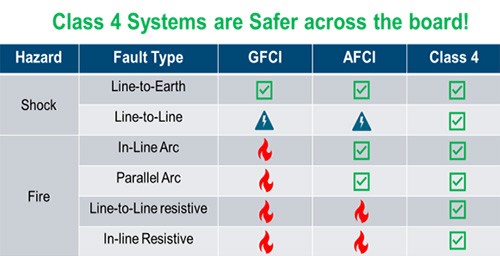The way we transmit and distribute power is undergoing a major transformation. For the first time in 45 years, the National Electrical Code (NEC) has introduced a new class of power: Class 4 Power or Fault Managed Power Systems (FMPS). These innovative power distribution systems represent a significant leap forward in the safe and efficient delivery of power across long distances.
Fault managed power systems are an end-to-end power delivery solution that combines advanced monitoring and control capabilities to provide unprecedented safety, flexibility, and efficiency, along with significant sustainability and cost benefits.
Let's dive into the details of how these systems work and the key benefits they unlock.
The Need for a New Power Class
The existing NEC power classes - Class 1, Class 2, and Class 3 - have served us well, but they have limitations that newer technologies are now overcoming.
- Class 1 power is the most widely used, with no power limits but it has higher safety risks related to fire and shock; stringent installation practices require a licensed electrician
- Class 2 is power limited to 100 W, and voltage limited to 60V; commonly installed in commercial buildings today as Power over Ethernet (PoE), it does not require the use of conduit, and can be installed by a low voltage contractor; cable wire gauge determines power and distance
- Class 3 is also power limited to 100 W but with voltage limited to 150V; commonly used in home theater and sound systems, it carries less fire risk, but shock hazard is comparable to Class 1; stringent installation practices require a licensed electrician.
As new power-hungry technologies have emerged, the industry has struggled to find the right balance of power capacity, safety, and installation flexibility. This led Underwriters Laboratories (UL) to collaborate with industry leaders like Panduit to develop a new safety standard to govern power delivery systems that don’t fit into one of the existing three power classes. The result of that was the publication of UL 1400-1 and UL 1400-2, which cover FMPS systems and FMPS cable.
Only a system that meets UL 1400-1 can be considered a Class 4 system. Fundamentally, FMPS and Class 4 systems work by limiting the amount of energy that goes into a fault.
The Key Components of a Fault Managed Power System
At the heart of a fault managed power system are two critical components - the power transmitter chassis (which includes the power supply unit and transmitter modules) and the power receiver:
- The power transmitter chassis takes standard power from the grid or a UPS and converts it into a higher voltage DC power signal; that DC power signal is then transformed into a pulsed waveform, which is the Class 4 circuit
- The pulse current is transmitted over Class 4 cable, classified under UL-1400-2 to the power receiver
- The power receiver converts the Class 4 pulsed current back into the required DC voltage (such as 48V DC) to power end devices

The key components of a fault managed power system are the power transmitter and a power receiver.
These components, along with the specialized Class 4 cabling, form a complete end-to-end fault managed power system.
Fault Management: The Key to Safety and Flexibility
The real innovation with FMPS lies in the advanced fault management capabilities. These systems are designed to constantly monitor the power circuit for a variety of fault conditions, including:
- Short circuits
- Line-to-line faults
- Ground faults
- Overcurrent conditions
- Malfunctions in the monitoring/control system
- Any other condition that could present a fire or shock hazar
If any of these fault conditions are detected, the power transmitter interrupts the flow of electricity within milliseconds. This rapid response time is critical for limiting the energy that goes into a fault and therefore mitigating the risks of fire and electric shock. (These Class 4 circuits can also be referred to as limited energy.)

Class 4 power systems are designed to mitigate fire and shock hazards, making them inherently safe.
By actively managing these faults, fault managed power systems provide the safety benefits of low-voltage power delivery, while still maintaining the high power capacity of traditional high-voltage systems, unlocking several key advantages:
- Safer installations: The fault management capabilities eliminate the need for the stringent wiring methods required for high-voltage Class 1 circuits; Class 4 systems use the same flexible, low-voltage methods as Class 2 circuits
- Higher power capacity: Unlike Class 2 and 3 systems which have strict power limits, FMP systems have no power limit, which means they can safely deliver hundreds or even thousands of watts over long distances
- Improved efficiency: By operating at higher voltages, Class 4 systems can transmit power more efficiently over long cable runs, reducing energy losses, to enhance both cost and sustainability
The Benefits of Class 4 Fault Managed Power Systems
The combination of high power capacity, flexible installation, and advanced safety features makes fault managed power an extremely versatile power distribution technology. Among the benefits:
- Safety and reliability: Class 4 FMPS systems are thoroughly tested and certified to UL 1400-1 and NEC Article 726 requirements to ensure they can reliably detect and mitigate all major fire and shock hazards; systems automatically reset after a fault is cleared, making them easier to manage remotely
- Significant cost savings: Compared to traditional high-voltage power distribution, Class 4 systems can achieve up to 60 percent savings on cabling costs and they can transmit 520 watts over 500 meters using just a pair of 16 AWG wires; this efficiency translates to major Capex and Opex savings
- Sustainability benefits: By maximizing power efficiency and minimizing resource usage, Class 4 systems contribute to a more sustainable future; the ability to deliver high power levels over long distances with thinner cables means less copper is required, representing a significant environmental advantage over legacy power distribution methods
- Flexibility and scalability: The fault management capabilities and lack of power limits make FMP systems extremely flexible for a wide range of applications, from powering edge computing devices to supplying electricity for industrial equipment; as power needs grow, the systems can be easily scaled up without major infrastructure changes
Real-World Applications for Fault Managed Power
The benefits of fault managed power make the power distribution platform well-suited to address a variety of power distribution challenges across industries, including:
- Edge Computing and 5G Infrastructure: Class 4 can efficiently power 5G cell sites, edge data centers, and other remote edge devices over long distances
- Industrial Automation: In factories and industrial facilities, Class 4 systems can safely and reliably deliver power to mission-critical equipment, sensors, and control systems - even in harsh environments
- Smart Buildings: FMPS can support the proliferation of IoT devices, lighting, HVAC, security cameras, and other building systems in today’s smart buildings
The Future is Fault Managed
Fault managed power systems represent a major advancement in how we distribute and manage electrical power. FMP systems bring together high-capacity, long-distance power delivery and advanced safety and control features, which will be transformative for a wide range of industries.
As the first fully compliant Class 4 FMPS solution, the Panduit FMP system is leading the way in this innovative new power class. With its combination of safety, cost savings, and sustainability benefits, the future of power distribution is here - and it's fault managed.
Dive deeper into FMPS in our Technology Brief: Fault Managed Power Systems / Class 4 Power.


